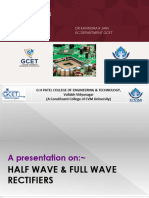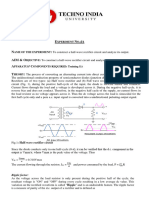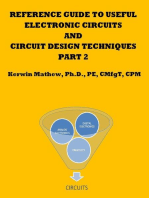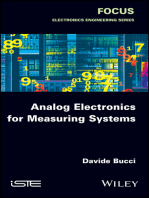Lab 04
Uploaded by
degag64086Lab 04
Uploaded by
degag64086EXPERIMENT NO -5
FULL-WAVE RECTIFIERS
AIM:
1. To observe waveform at the output of full wave rectifier with and without filter capacitor.
2. To measure DC voltage, DC current, ripple factor with and without filter capacitor.
EQUIPMENT:
Transformer (center tapped) 12-0-12 V AC, 500 mA - 1 No._______________
Diode 1N4007 -2
Resistor 10K -1
Capacitor 1000µF -1
Toggle Switch
Breadboard
Connecting wires
Keep toggle switch OFF to perform practical of full wave rectifier without filter capacitor and
ON to connect filter capacitor.
THEORY:
Full wave rectifier utilizes both the cycle of input AC voltage. Two or four diodes are used in
full wave rectifier. If full wave rectifier is designed using four diodes it is known as full wave
bridge rectifier. Full wave rectifier using two diodes without capacitor is shown in the following
figure. Center tapped transformer is used in this full wave rectifier.
During the positive cycle diode D1 conducts and it is available at the output. During negative
cycle diode D1 remains OFF but diode D2 is in forward bias hence it conducts and negative
cycle is available as a positive cycle at the output as shown in the following figure. Note that
direction of current in the load resistance is same during both the cycles hence output is only
positive cycles.
40 Electronic Devices and Circuits (EE-300) | [Military College of Signals]
THEORITICAL CALCULATIONS:
Vrms = Vm/ √2
Vm =Vrms√2
Vdc=2Vm/П
(i)Without filter:
Ripple factor, r = √ (Vrms/ Vdc )2 -1 = 0.812
(ii)With filter:
Ripple factor, r = 1/ (4√3 f C RL)
41 Electronic Devices and Circuits (EE-300) | [Military College of Signals]
Advantages of full wave rectifier over half wave rectifier:
The rectification efficiency is double that of half wave rectifiers. Ripple factor is less and ripple
frequency is double hence easy to filter out. DC output voltage and current is higher hence
output power is higher. Better transformer utilization factor.
1. The rectification efficiency is double than half wave rectifier
2. Ripple factor is less and ripple frequency is double hence easy to filter out.
3. DC output voltage and current is higher hence output power is higher.
4. Better transformer utilization factor.
5. There is no DC saturation of core in transformer because the DC currents in two halves of
secondary flow in opposite directions.
Circuit Diagram:
Waveforms:
[1] Without Filter Capacitor: Input Waveform at secondary of transformer:
42 Electronic Devices and Circuits (EE-300) | [Military College of Signals]
Output Waveform:
[2] With Filter Capacitor: Input Waveform at secondary of transformer:
Output Waveform:
Observations:
[1] Without Filter Capacitor
AC Input voltage (rms) Vrms= ___________
DC output voltage VDC = ___________
43 Electronic Devices and Circuits (EE-300) | [Military College of Signals]
DC current: IDC =______________
AC output voltage (Ripple voltage) Vr: __________
Ripple factor: (Vr/VDC) = ______________
[2] With Filter Capacitor
AC Input voltage (rms) Vrms= ___________
DC output voltage VDC = ___________
DC current: IDC =______________
AC output voltage (Ripple voltage) Vr: __________
Ripple factor: (Vr/VDC) = ______________
CONCLUSION:
POST LAB QUESTIONS:
1. What is the frequency of AC components at the output of full wave rectifier? Give reason.
2. What is the difference in DC output voltage in half wave and full wave rectifiers for the same
AC input?
44 Electronic Devices and Circuits (EE-300) | [Military College of Signals]
3. Define peak inverse voltage (PIV)? And write its value for Full-wave rectifier?
4. What is the mathematical relationship between rms input AC voltage and DC output voltage in
half wave rectifiers with and without filter capacitor?
5. Does the process of rectification alter the frequency of the waveform?
6. What is the necessity of the transformer in the rectifier circuit?
7. Explain how capacitor helps to improve the ripple factor?
45 Electronic Devices and Circuits (EE-300) | [Military College of Signals]
You might also like
- Electronic Principles and Circuits Lab Manual - BEC303 - 18-11-202350% (2)Electronic Principles and Circuits Lab Manual - BEC303 - 18-11-202369 pages
- 1401-0310-024-11 - Service Manual System Sophi and Sophi ANo ratings yet1401-0310-024-11 - Service Manual System Sophi and Sophi A78 pages
- Solar Kit Hungary - Wholesale Catalogue 2023.03No ratings yetSolar Kit Hungary - Wholesale Catalogue 2023.0332 pages
- Introduction To Parallel Computing, Second Edition-Ananth Grama, Anshul Gupta, George Karypis, Vipin KumarNo ratings yetIntroduction To Parallel Computing, Second Edition-Ananth Grama, Anshul Gupta, George Karypis, Vipin Kumar2 pages
- Full Wave Centre Tapped Rectifier: Experiment No. 5No ratings yetFull Wave Centre Tapped Rectifier: Experiment No. 54 pages
- Full Wave Bridge Rectifier: Experiment No. 6No ratings yetFull Wave Bridge Rectifier: Experiment No. 65 pages
- Half Wave Rectifier and Full Wave RectifierNo ratings yetHalf Wave Rectifier and Full Wave Rectifier4 pages
- Exp_2 Halfwae & Fullwave Diode RectifierNo ratings yetExp_2 Halfwae & Fullwave Diode Rectifier11 pages
- Half Wave Rectifier and Full Wave RectifierNo ratings yetHalf Wave Rectifier and Full Wave Rectifier5 pages
- 4574_65_111_Integrated_Circuits_lab__manual-1No ratings yet4574_65_111_Integrated_Circuits_lab__manual-116 pages
- Experiment - 4 Half Wave Rectifier Pre - Lab QuestionsNo ratings yetExperiment - 4 Half Wave Rectifier Pre - Lab Questions8 pages
- Tripura Institute of Technology: A Presentation OnNo ratings yetTripura Institute of Technology: A Presentation On17 pages
- IPCC EPC Lab Manual-2023 - 231117 - 094512 (1) - 231120 - 121052No ratings yetIPCC EPC Lab Manual-2023 - 231117 - 094512 (1) - 231120 - 12105279 pages
- Ecgr3155-Experiment 4-Diodes and Bridge RectifiersNo ratings yetEcgr3155-Experiment 4-Diodes and Bridge Rectifiers8 pages
- Electronic Devices and Circuits Lab - Full Wave Rectifier With and Without Filters - Notes - SboNo ratings yetElectronic Devices and Circuits Lab - Full Wave Rectifier With and Without Filters - Notes - Sbo6 pages
- Electronic Components Circuits: (Diode Characteristies - Rectifier - Clipper)No ratings yetElectronic Components Circuits: (Diode Characteristies - Rectifier - Clipper)14 pages
- D - Jayakumar Ece Ece Ece Viva Questions-Jk56% (9)D - Jayakumar Ece Ece Ece Viva Questions-Jk20 pages
- International Islamic University Chittagong: Department of Computer Science and EngineeringNo ratings yetInternational Islamic University Chittagong: Department of Computer Science and Engineering4 pages
- Experiment - 5: Full Wave Rectifier Pre - Lab QuestionsNo ratings yetExperiment - 5: Full Wave Rectifier Pre - Lab Questions7 pages
- Electronic Devies and Circuits Lab Report: Experiment # 4No ratings yetElectronic Devies and Circuits Lab Report: Experiment # 48 pages
- Design and Study Full-Wave and Bridge Rectifier and100% (1)Design and Study Full-Wave and Bridge Rectifier and27 pages
- 10ESL37 - Analog Electronics Lab ManualNo ratings yet10ESL37 - Analog Electronics Lab Manual69 pages
- Reference Guide To Useful Electronic Circuits And Circuit Design Techniques - Part 1From EverandReference Guide To Useful Electronic Circuits And Circuit Design Techniques - Part 12.5/5 (3)
- Reference Guide To Useful Electronic Circuits And Circuit Design Techniques - Part 2From EverandReference Guide To Useful Electronic Circuits And Circuit Design Techniques - Part 2No ratings yet
- HughesNet AN8-074R .74m KA-Band Antenna - Pointing GuideNo ratings yetHughesNet AN8-074R .74m KA-Band Antenna - Pointing Guide56 pages
- 2-1328-PE-PACKING-01 RA Packing & Preservation ProcedureNo ratings yet2-1328-PE-PACKING-01 RA Packing & Preservation Procedure8 pages
- RS232 Communication With PIC MicrocontrollerNo ratings yetRS232 Communication With PIC Microcontroller5 pages
- DWV, Are Used For Drainage, Waste and Vent. Commonly Used Are The Series 600 andNo ratings yetDWV, Are Used For Drainage, Waste and Vent. Commonly Used Are The Series 600 and2 pages
- Air Compress Parts Product List From ONWISENo ratings yetAir Compress Parts Product List From ONWISE3 pages
- Electronic Principles and Circuits Lab Manual - BEC303 - 18-11-2023Electronic Principles and Circuits Lab Manual - BEC303 - 18-11-2023
- 1401-0310-024-11 - Service Manual System Sophi and Sophi A1401-0310-024-11 - Service Manual System Sophi and Sophi A
- Introduction To Parallel Computing, Second Edition-Ananth Grama, Anshul Gupta, George Karypis, Vipin KumarIntroduction To Parallel Computing, Second Edition-Ananth Grama, Anshul Gupta, George Karypis, Vipin Kumar
- Full Wave Centre Tapped Rectifier: Experiment No. 5Full Wave Centre Tapped Rectifier: Experiment No. 5
- Experiment - 4 Half Wave Rectifier Pre - Lab QuestionsExperiment - 4 Half Wave Rectifier Pre - Lab Questions
- Tripura Institute of Technology: A Presentation OnTripura Institute of Technology: A Presentation On
- IPCC EPC Lab Manual-2023 - 231117 - 094512 (1) - 231120 - 121052IPCC EPC Lab Manual-2023 - 231117 - 094512 (1) - 231120 - 121052
- Ecgr3155-Experiment 4-Diodes and Bridge RectifiersEcgr3155-Experiment 4-Diodes and Bridge Rectifiers
- Electronic Devices and Circuits Lab - Full Wave Rectifier With and Without Filters - Notes - SboElectronic Devices and Circuits Lab - Full Wave Rectifier With and Without Filters - Notes - Sbo
- Electronic Components Circuits: (Diode Characteristies - Rectifier - Clipper)Electronic Components Circuits: (Diode Characteristies - Rectifier - Clipper)
- International Islamic University Chittagong: Department of Computer Science and EngineeringInternational Islamic University Chittagong: Department of Computer Science and Engineering
- Experiment - 5: Full Wave Rectifier Pre - Lab QuestionsExperiment - 5: Full Wave Rectifier Pre - Lab Questions
- Electronic Devies and Circuits Lab Report: Experiment # 4Electronic Devies and Circuits Lab Report: Experiment # 4
- Design and Study Full-Wave and Bridge Rectifier andDesign and Study Full-Wave and Bridge Rectifier and
- Reference Guide To Useful Electronic Circuits And Circuit Design Techniques - Part 1From EverandReference Guide To Useful Electronic Circuits And Circuit Design Techniques - Part 1
- Reference Guide To Useful Electronic Circuits And Circuit Design Techniques - Part 2From EverandReference Guide To Useful Electronic Circuits And Circuit Design Techniques - Part 2
- HughesNet AN8-074R .74m KA-Band Antenna - Pointing GuideHughesNet AN8-074R .74m KA-Band Antenna - Pointing Guide
- 2-1328-PE-PACKING-01 RA Packing & Preservation Procedure2-1328-PE-PACKING-01 RA Packing & Preservation Procedure
- DWV, Are Used For Drainage, Waste and Vent. Commonly Used Are The Series 600 andDWV, Are Used For Drainage, Waste and Vent. Commonly Used Are The Series 600 and

























































































